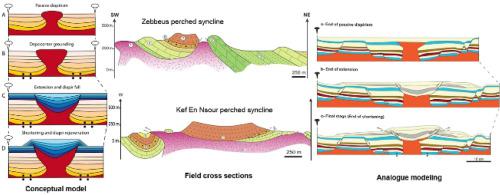Journal of Structural Geology ( IF 3.1 ) Pub Date : 2021-04-06 , DOI: 10.1016/j.jsg.2021.104336 Nedhir Sebai , Bruno C. Vendeville , Noureddine Boukadi , Ferid Dhahri

|
Central Tunisia has been subjected to a complex series of successive regional tectonic phases, both extensional and compressional. This history is made even more complex by the presence of mobile Triassic evaporites that generated halokinetic deformation and partly decoupled the subsalt “basement” from the overburden.
At the southern end of a major regional lineament called “the North-South Axis” are some enigmatic structures (described as “Perched Synclines” in the literature) cored by the Upper Eocene Jebs Formations: the Kef En Nsour and Zebbeus structures. The core of these structures is made of synform (concave-upward) strata of Upper Cretaceous to Cenozoic age resting unconformably onto the Triassic evaporites. A significant part of the stratigraphic series (i.e., Lower Cretaceous) is missing. The Cenozoic strata are particularly thick within the synclines, whereas they are thin or absent outside the synclines. These form topographic highs raised above the regional datum. In contrast, the Mesozoic series is continuous and thicker outside the synclines.
We hypothesize that these so-called “perched synclines” have a halokinetic, rather than a solely tectonic origin. The absence of parts of the lower stratigraphic series in the center of the structure indicates that the Triassic evaporites were rising as a passive diapir. During the Cenozoic, source-layer depletion combined with local extension forced the diapir to fall and its crest to subside, thus trapping thicker overburden strata within the syncline and bending them, resulting in a concave-upward geometry. During the latest stage a phase of N–S regional shortening rejuvenated the fallen diapir, raising its synform roof above the regional datum.
We provide field and geophysical data, as well as results from a set of analogue models to test and validate such a Rise-Fall-Rise structural history. The final geometry changes when varying the amounts and rates of passive diapir rise, sedimentation, extension, and late shortening. Results from most experiments closely match the geometries of the field examples from Central Tunisia. In addition, one model, in which the amount of diapir fall (and extrusion) was extreme, is very similar to the Tunb Diapir located offshore SW Iran.
中文翻译:

突尼斯中部的栖息向斜线相似:地下洞上升–下降–上升的实例由田野,地球物理和实验数据说明
突尼斯中部经历了一系列复杂的连续区域构造阶段,包括伸展期和压缩期。由于存在流动的三叠纪蒸发岩,其发生了速动变形,并使盐分的“基层”与上覆岩部分脱开,使这一历史变得更加复杂。
在一个主要的区域性系的南端,被称为“南北轴”的是一些神秘的构造(在文献中被描述为“栖息向斜”),由始新世的杰布斯构造为核心:Kef En Nsour和Zebbeus构造。这些结构的核心是由上白垩统至新生代的同形(凹向上)地层不整合地搁置在三叠纪蒸发岩上。地层系列的重要部分(即下白垩统)缺失了。新生代地层在向斜线内特别厚,而在向斜线外则薄或不存在。这些形成了高于区域基准面的地形高点。相反,中生代系列是连续的,在向斜线外更厚。
我们假设这些所谓的“栖息向斜线”具有卤代动因,而不是单纯的构造起源。在结构中心没有下部地层系列的部分,表明三叠纪蒸发岩作为被动底辟上升。在新生代,源层的耗竭与局部扩张相结合,迫使底辟陷落,其顶峰消退,从而将较厚的上覆地层截留在向斜内并使其弯曲,从而形成了一个凹向上的几何形状。在最近阶段,NS区域缩短的一个阶段使下落的diapir焕发了青春,将其同形屋顶提高到了区域基准以上。
我们提供现场和地球物理数据,以及来自一组模拟模型的结果,以测试和验证这种Rise-Fall-Rise结构历史。当改变被动底盘上升,沉降,伸展和后期缩短的数量和速率时,最终的几何形状会发生变化。大多数实验的结果都与突尼斯中部实地实例的几何形状非常吻合。此外,有一个模型,diapir下降(和挤压)的数量非常大,这与位于伊朗西南海域的Tunb Diapir非常相似。



























 京公网安备 11010802027423号
京公网安备 11010802027423号